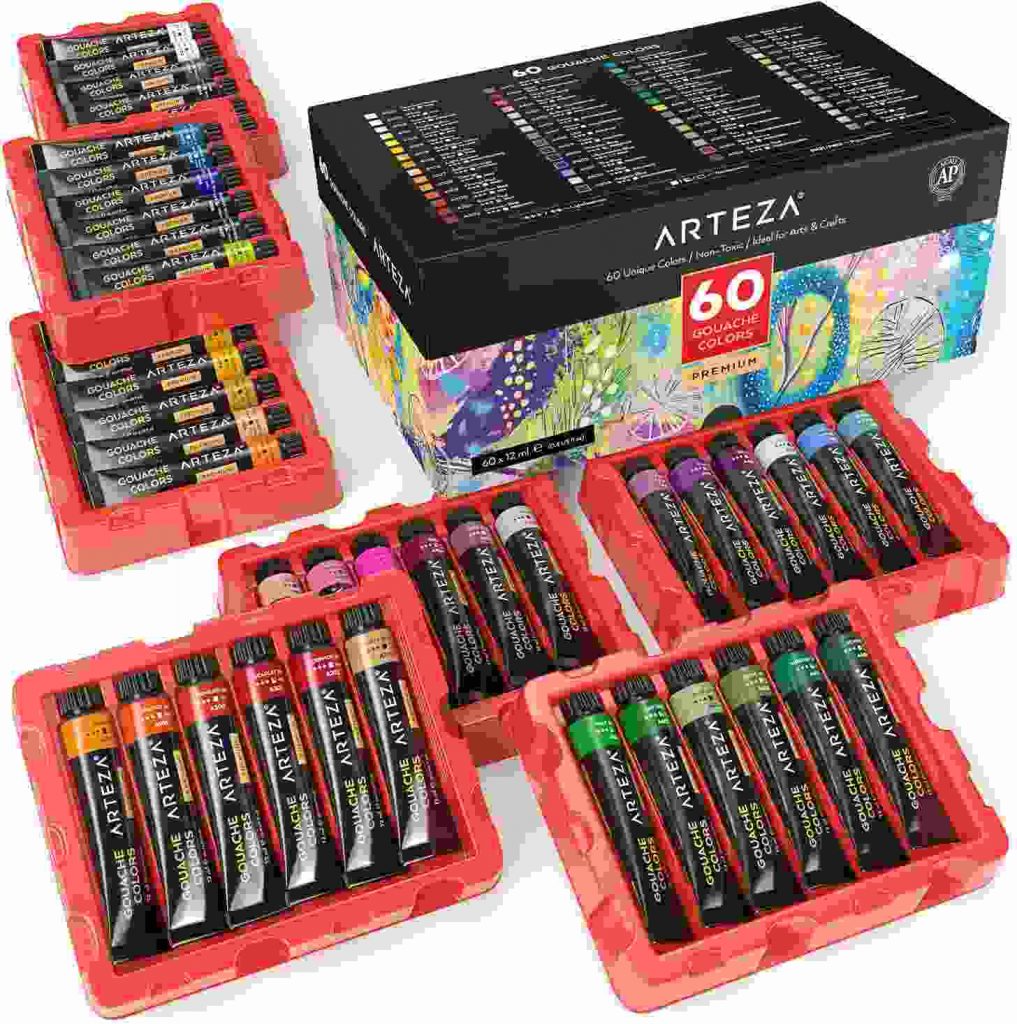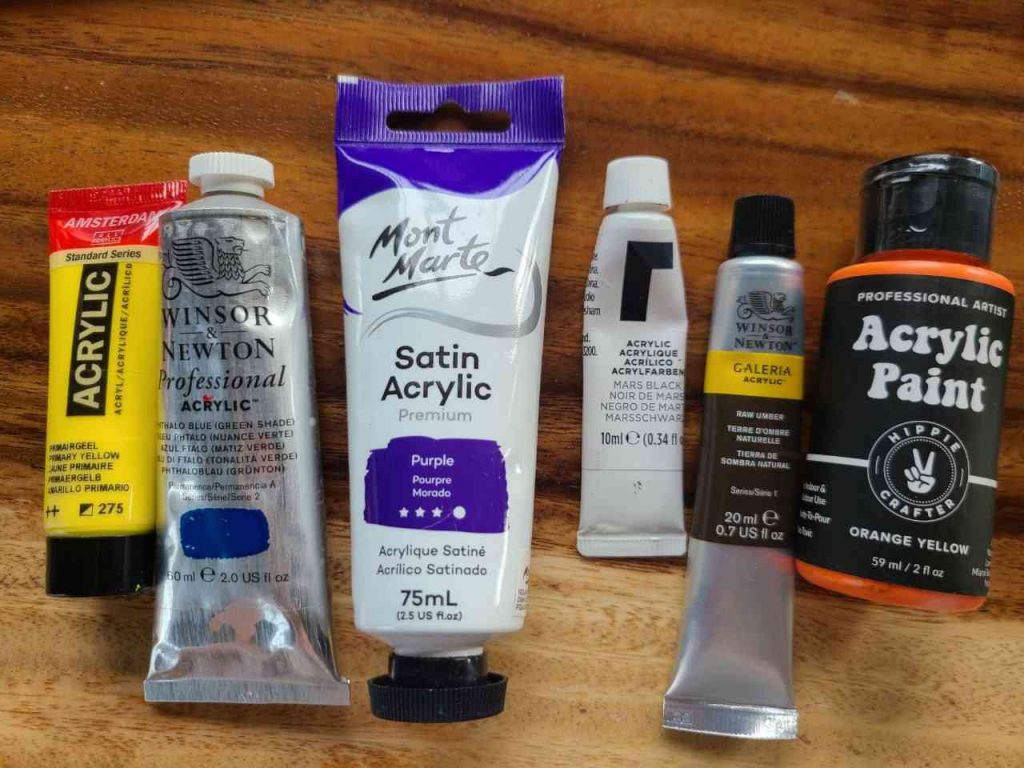Last Updated on November 19, 2023 by Masha Eretnova
For beginner painters, gouaches and acrylics are two flexible paint mediums to try learning how to blend colors to create art.
They are budget-friendly, and you don’t often need a lot of other materials like primers and mediums to work with them.
A paintbrush, palette, and paper are all you need to get started. But which one to get? In selecting gouache vs acrylic, which media is the best for you?
Acrylic paint is fast-drying, glossy, water-resistant, and more durable than gouache. Gouache is easier to paint with than acrylics, is washable, and dries to a velvety matte finish. Gouache is more expensive than acrylics and less toxic to use.
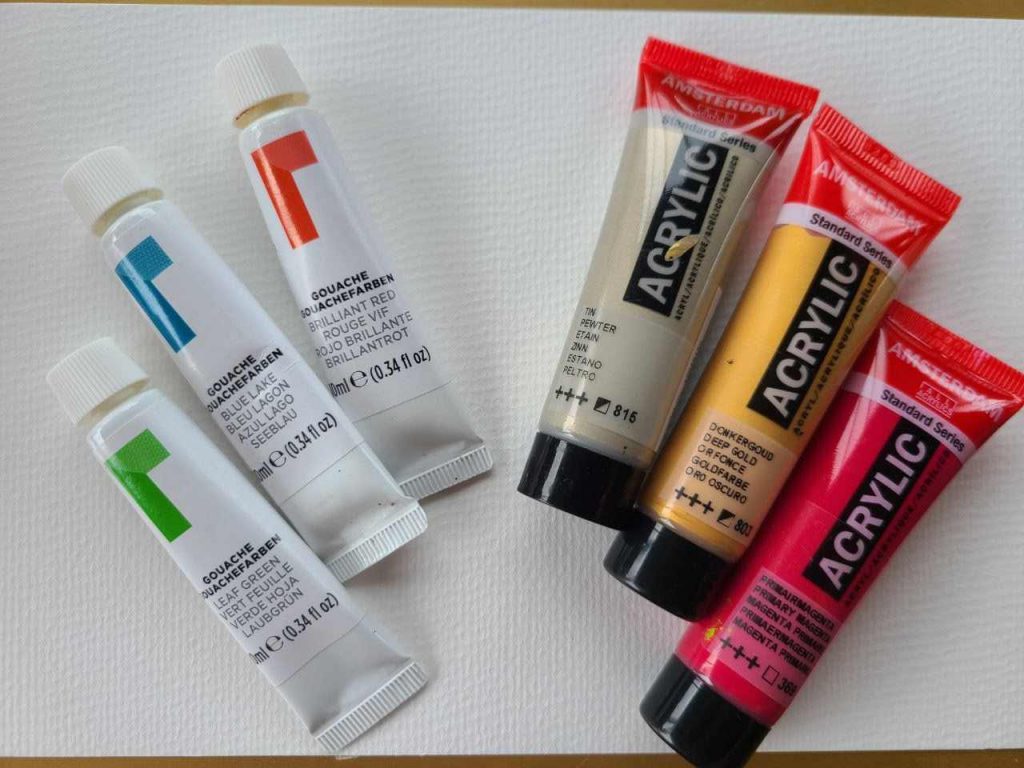
For this article I will include illustrations using colors from Reeves acrylic paint, Reeves Gouache, Amsterdam acrylic, Winsor & Newton Professional Acrylics, and Pebeo Studio Watercolor.
Table of Contents
My blog is supported by readers and can contain affiliate links. They mean NO extra cost for you, but a tiny commission for me to keep going.
Gouache Paint vs Acrylic At A Glance
| Gouache | Acrylic | |
| Paint composition | Water, pigment, white extender, and a gum arabic (or dextrin) binder | Water, pigment, and acrylic polymer emulsion binder |
| Consistency | Soft body and creamy | May be heavy or soft-bodied, fluid, or high flow |
| Dry time | ~10-30 minutes, but can be reactivated with water | ~10-20 minutes |
| Opacity | Opaque | Opaque |
| Preparation | Does not need a primer | May need a primer, depending on the painting surface |
| Price | More expensive than acrylic | Can be less or more expensive than gouache, depending on the paint grade |
| Painting surfaces | Limited surfaces, mostly paper and other non-oily surfaces like wood and cardboard | Most surfaces are good for gouache painting, including paper or illustration board, wood, canvas, glass, plastic, fabric, etc. |
| Mixing and blending colors | Easier because it can be reworked with water several times | Harder as it dries easily |
| Layering and available techniques | Can be layered; has several available techniques like wet-on-wet or dry-on-wet | It can be layered; has several techniques, including dry brushing, acrylic pouring, and wet-on-wet |
| Color lifting | Yes | Yes |
| Finish | Matte chalky finish | Glossy finish |
| Durability | Less durable | More durable |
| Toxicity and safety | Generally non-toxic | Some ingredients can be toxic |
| Waterproof/water resistance | Traditional gouache – not water-resistant Acrylic gouache – water-resistant | Water-resistant |
| Mediums and add-ons | Can be used with watercolor paints, acrylic paint, colored pencils, watercolor pencils, markers, and charcoals | More versatile. Can be used with other paint mediums, colored pencils, and charcoal, modeling pastes, slow-drying mediums, fabric mediums, pouring, and many more |
| Best paints | 15 Best Gouache Paint Sets For Beginners and Pros | Best Acrylic Paint: 20+ Brands Reviewed for Beginners [From Cheap to Pro] |
You can also see quick infographic on key differences between gouache and acrylic:
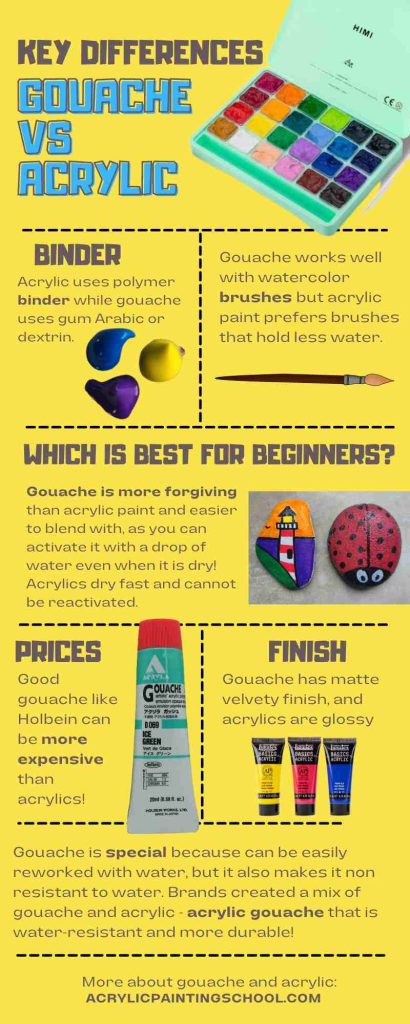
Read also:
- Watercolor vs Acrylic: 21 Differences Between Acrylic and Watercolor
- Poster Paint vs Acrylic Paint: What’s the Difference and Which is best?
- Gouache vs Watercolor: How do they differ and which is best?
What is special about gouache paint?
Gouache is a non-permanent water-based paint made of water, natural pigments, and a binder like gum arabic or dextrin.
Gouache is like opaque watercolor.
Gouache has also been around for over ten centuries, far longer than acrylics, with records showing Ancient Egyptian paintings made from this medium.
However, it is often considered a cross between acrylics and watercolors because it has the same consistency as watercolor paint and the high pigmentation and opacity of acrylics.
It is well-known for this distinct quality — it can be reactivated and reworked several times with water.
This is very forgiving for beginner painters trying to practice their blending skills.
You can easily soften the painted area with a wet brush, add new colors, or lighten certain parts of your artwork for contrast.
There are 3 main types of gouache:
- traditional gouache,
- acrylic gouache (also called acryla)
- jelly gouache
The major difference between traditional gouache and acrylic gouache is the binder.
Traditional gouache uses gum arabic, while acrylic gouache has an emulsion-based binder.
Furthermore, acrylic gouache is much similar to acrylics that it dries permanently and cannot be reworked with water.
Jelly gouache is another gouache set available on the market. It is traditional gouache packed in jelly cups, not acrylic gouache.
Best gouache paints for beginners:
- Arteza Gouache Paint (set of 60) – Best overall 🏆 (Full Review)
- Himi Gouache Paint (set of 24) – Runner up ( I use this one!)
- Talens Art Creation Gouache (set of 12)
- Miya Jelly Gouache Paint (set of 56)
- Reeves Gouache (I personally tried it, decent quality but can go bad)

Best gouache paints for professionals
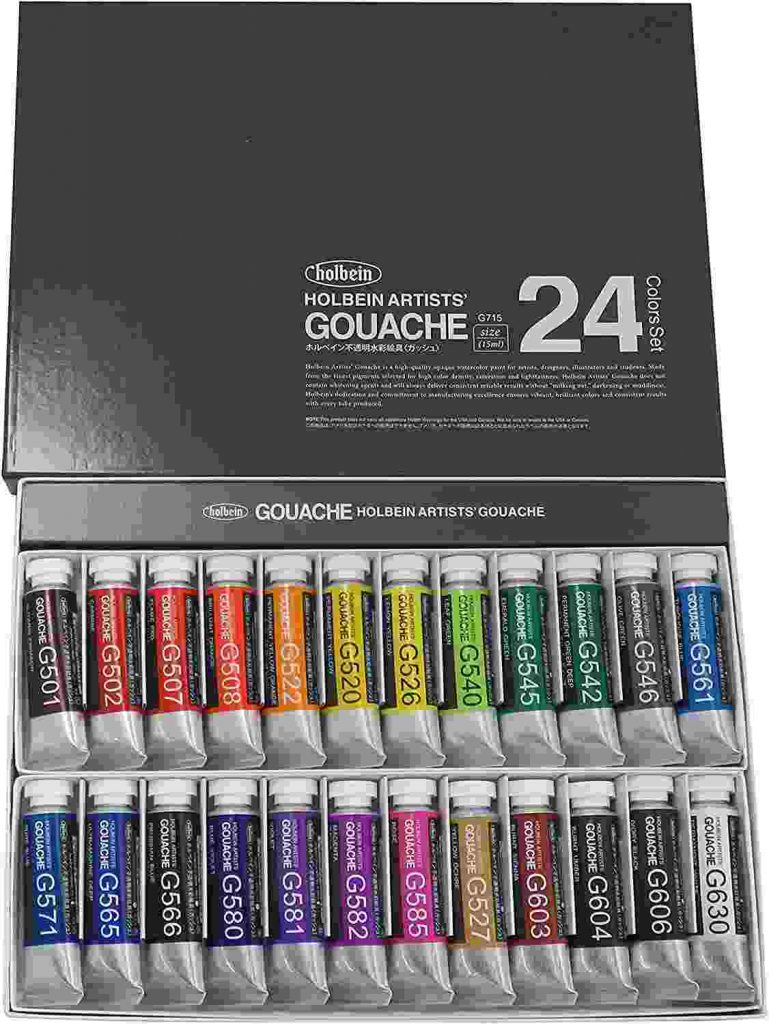
What is acrylic paint?
Acrylic paint is a water-based paint medium combined with acrylic polymer and color pigments.
It is favored by many artists for its lightfastness, durability, and water resistance.
It is also thicker than watercolor or gouache and is great for creating textures in painted artworks.
Acrylic paints can adhere to almost all surfaces from paper to concrete. And because it dries quickly, it is easier to create crisp, neat lines in your artwork.
However, it also makes it harder to blend colors, especially when you’re only starting to learn how to. Finally, when the paint has dried, you cannot rework them anymore.
Best acrylic paints for beginners:
- Liquitex Basic Acrylic (set of 12)
- Arteza Acrylic Paint (set of 24)
- Mont Marte Acrylic Paint (set of 24)
Best artist-grade acrylic paint brands for professionals:
Related: Best Acrylic Paint: 21 Brands Reviewed for Beginners [From Cheap to Pro]
What is the difference between gouache and acrylic Paint?
Gouache and Acrylic Paints Have Different Paint Composition
Gouache and acrylic are water-based but they don’t have the same binder.
Gouache uses a Arabic gum binder, sometimes along with a white extender or simple chalk that makes it opaque.
In comparison, acrylic gouache uses an emulsion-based binder, making it water-resistant and durable like acrylic paints.
Unlike gouache, acrylics use acrylic polymer solution as a binder that helps them become water-resistant and glossy when dry.
Acrylic paint contains more preservatives and some of the pigments can be harmful, like cadmium.
But most gouache paint uses natural pigments.
Gouache vs Acrylic Paint: Consistency
Traditional and acrylic gouache have thick, almost like a heavy cream consistency.

Acrylics, on the other hand, come in different types of consistency:
- Heavy body – thickest and able to hold shape; perfect for creating textures
- Soft body – slightly viscous
- Open acrylics – softer acrylics specifically made for longer drying time
- Fluid – has a creamy consistency
- High flow – very fluid and similar to acrylic inks and watercolor in consistency, perfect for pouring.
- Acrylic inks – extremely fluid.
Both paints are water-soluble and the consistency can be adjusted with the right amount of water. Yet, if for gouache water amount is not a crucial factor, for acrylic it is.
You cannot have too much water in acrylic paints, it will ruin the bond between acrylic binder and the pigments.
You should keep the water ratio under 50% (I would recommend even under 30%) and adding GAC100 to paint to make it more stable.
Read also: How to Thin Acrylic Paint: 3 Correct Ways & 3 Dont’s How to Fix Lumpy & Chunky Acrylic Paint? [10 Easy Methods]
Dry time
The dry time of acrylic and gouache is quick.
But gouache dries in approximately 10 to 30 minutes, while acrylics dry in about 10 to 20 minutes, depending on the type.
If you’re using acrylic and want a longer drying time, select soft-bodied acrylics for your art project.
Dry times also affect the unused paint on your palette and brushes.
Therefore, immediate washing is necessary to avoid crusting palettes and brushes for quick-drying acrylic. Once the acrylic is dried out, you cannot revive it with water.
Tip: How to Rehydrate Acrylic Paint: 14 Good & Bad Ways To Soften Acrylics
Gouache dries less quickly and can be reactivated several times with water. So, you have more control over your artwork.
This also means that dried gouache will not ruin your brush or palette.
Opacity
Gouache and acrylic wet and dry paint is opaque.
And you can even improve the opacity of these mediums using layers of paint or gesso.
Also, note that gouache dries lighter, while some acrylic colors dry darker.
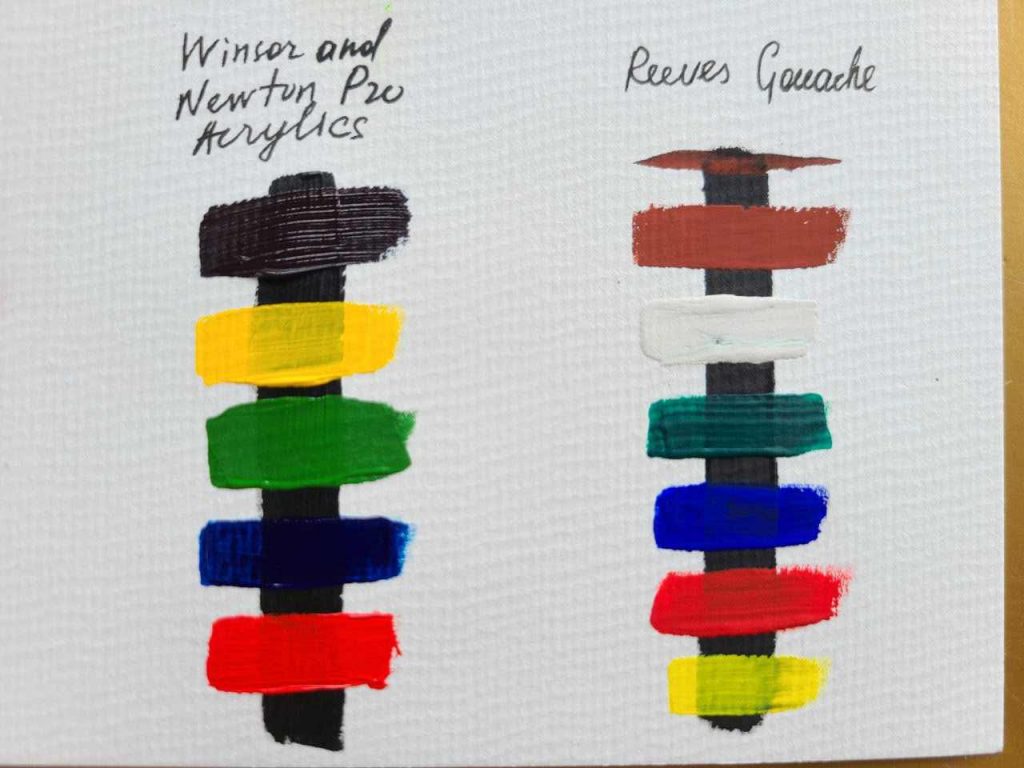
Keep reading: 7 Ways How to Make Acrylics More Opaque & Full Opaque Colors List
Preparation
Unlike oil paints, gouache and acrylic do not necessarily require much preparation in terms of priming and materials needed before use.
Especially with gouache, you will only need your brush, a palette for mixing, and water.
However, you may want to go the extra by priming the paper with a thin layer of acrylic when painting with gouache to ensure no white space is left in the painting.
Do you need a primer for acrylic painting? Yes and no.
Most canvasses in stores are pre-primed, so there is no need to add another layer of primer. Unless you think that the canvas has a very thin layer of primer.
Other surfaces like raw wood or canvas need a primer to prevent too much paint from soaking into them.
Price
Gouache is generally more expensive than acrylic paints because it has more pigments mixed in with binder, which contributes to its opacity (compared to watercolor painting).
However, there are types like jelly gouache paint (basically a traditional gouache) available in jelly boxes that are more affordable for artists on a budget.
But this is not professional-grade gouache paint.
Higher-grade gouache paints are also even more expensive.
Beginner-grade gouache retails at about $1-$2/US fl oz, while professional-grade gouache is at $10-$40/US fl oz.
Acrylic paint is cheaper than gouache, but that can change depending on the grade and consistency you need.
Higher professional and artist-grade acrylics are more durable but come at a heftier price.
Generally, beginner-grade acrylic is about $1-$4/US fl oz, and professional grade is $4-$20/US fl oz.
You may check the price comparison of prices and grades in this table:
| Beginner Grade Gouache vs. Acrylic | |||
| Arteza Gouache Paint (60 colors) | around $50 | Arteza Acrylic Paint (60 colors) | around $55 |
| Himi Gouache Paint (56 colors) | around $53 | Mont Marte Acrylic Paint (48 colors) | around $50 |
| Liquitex Gouache (12 colors) | around $52 | Liquitex Basic Acrylic (12 colors) | $33.45 |
| Professional Grade Gouache vs. Acrylic | |||
| Holbein’s Artist Gouache (24 colors) | around $110 | Holbein Acrylic Colors – Heavy Body | $88.40 |
| M. Graham Gouache (5 colors) | $45.77 | M. Graham Acrylic (6 colors) | around $43 |
| Schmincke Gouache (10 colors) | around $150 | Golden Acrylics – Heavy Body (6 colors) | around $30 |
Painting surfaces
Gouache, like watercolor, is primarily used with paper.
But you can also use it with large mat boards, illustration board, watercolor paper, and other non-oily surfaces.
You can also try to paint gouache on wood, but you have to put primer on its surface and seal it after painting.
In contrast, almost any material can be acrylic paint surfaces.
Because this paint dries quickly and permanently, it can be used with wood, paper, fabric and leather, plastics, glass and ceramics, and even metal or concrete.
You will, however, need to prime these painting surfaces to avoid too much paint from being absorbed by the material.
Mixing and blending colors
Gouache is easier to mix and blend because it can be reworked with water.
So, you can add wet paint on top of dried paint and blend.
Acrylics don’t share this ability. If it is already dried, you can no longer blend colors on it.
Acrylic gouache is a gouache that becomes permanent when dried and is not reworkable with water.
Mixing new colors is equally easy with gouache and acrylics:

Read also: 11 Ways on How to Blend Acrylic Paint Smoothly
Layering and available techniques
There are a lot of acrylic painting techniques that you can try, even as a beginner, to make your artwork look like a pro.
These include acrylic pouring, wet-on-wet, painting in blocks, and painting with a palette knife.
Like acrylic, there are also different gouache painting techniques to try.
They include glazing, dry brushing, wet-on-wet, and wet-on-dry.
Gouache can also be layered but use drier brushes when applying another layer, and in general it is more challenging than with acrylic paint, acrylic layers are easier.
Check also: WOW Acrylic Pouring Techniques for Beginners and Advanced Artists
Color lifting
Both gouache and acrylic can be lifted.
However, gouache is more easily lifted or muddied when used with too much water or when the previous layer is still too wet.
Similarly, using too much water with acrylic paints may weaken their bond to your painting surface and cause color lifting or paint to not stick on the surface.
Tip: Why Is My Paint Watery? 15 Ways To Thicken Paint
Paint Finish
While gouache and acrylic dry opaque, and they don’t have the same finishes. Gouache is often duller and matte, while acrylic is glossier:

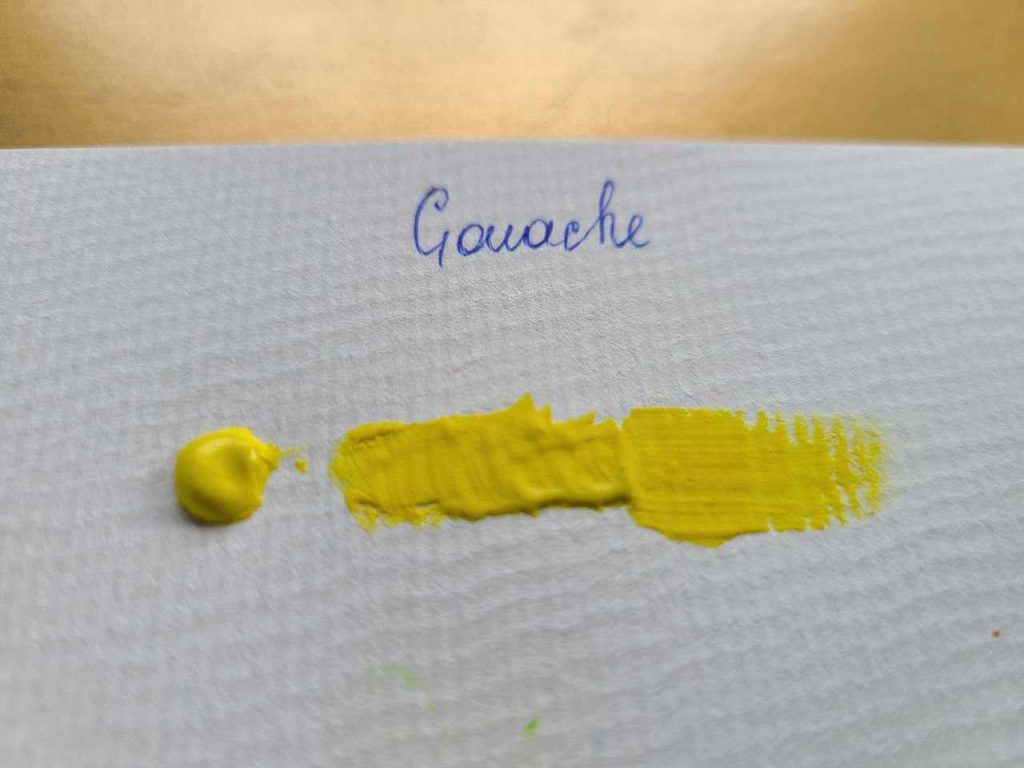
Matte acrylic paint also exists. You can either buy craft paints that are already matte, like matte Apple Barrel paint, or use matte varnish to flatten the natural gloss of acrylics.
Durability
Both gouache and acrylic have artist-grade options.
Often, these types are more durable and lightfast. However, acrylic painting is still more durable than gouache because it is water-resistant and will not reactivate once dried.
It is also made to stand time and is UV-resistant.
It is not advisable to varnish gouache projects at all or at least immediately after working on them, as it can reactivate the paint.
Instead, wait several weeks or at least a month to ensure the artwork is fully dried.
Dried gouache is also brittle and prone to breaking. Making gouache waterproof is more challenging than waterproofing acrylic painting.
Water-based varnishes are recommended for acrylic paintings, to seal your art and make the output more durable and waterproof, protected from dust and sunlight, but also easier to clean.
Keep reading: 5 Pro Steps to Protect Acrylic Paintings on Canvas
Toxicity and safety
Gouache is predominantly made with natural products, which is why it is more expensive and often safe to use.
On the other hand, acrylics are made of chemicals, and some may be toxic and unsafe to use, especially on the skin.
Its smell can also irritate your eyes and nose.
Note that some color pigments included in gouache, acrylic, and other painting mediums may still be toxic.
So, always check the manufacturer’s manual for safety measures.
And always use your paints in a well-ventilated room to avoid inhaling irritants.
Also, don’t try spraying or scraping paint off a surface once dried, as this action creates small particles that are dangerous to inhale.
For reference, some of the toxic pigments in colors are:
- Mercuric sulfide in vermillion
- Lead chromate in cobalt yellow
- Cadmium sulfide in cadmium colors (red, orange, and yellow)
Waterproof/water resistant
Both paints are not waterproof, but acrylic is water-resistant when dry while gouache can be still reactivated with water.
I have a small gouache painting that is more than 2 years old, and I tested it: if I add a few drops of water I can wash off colors and reactivate them!
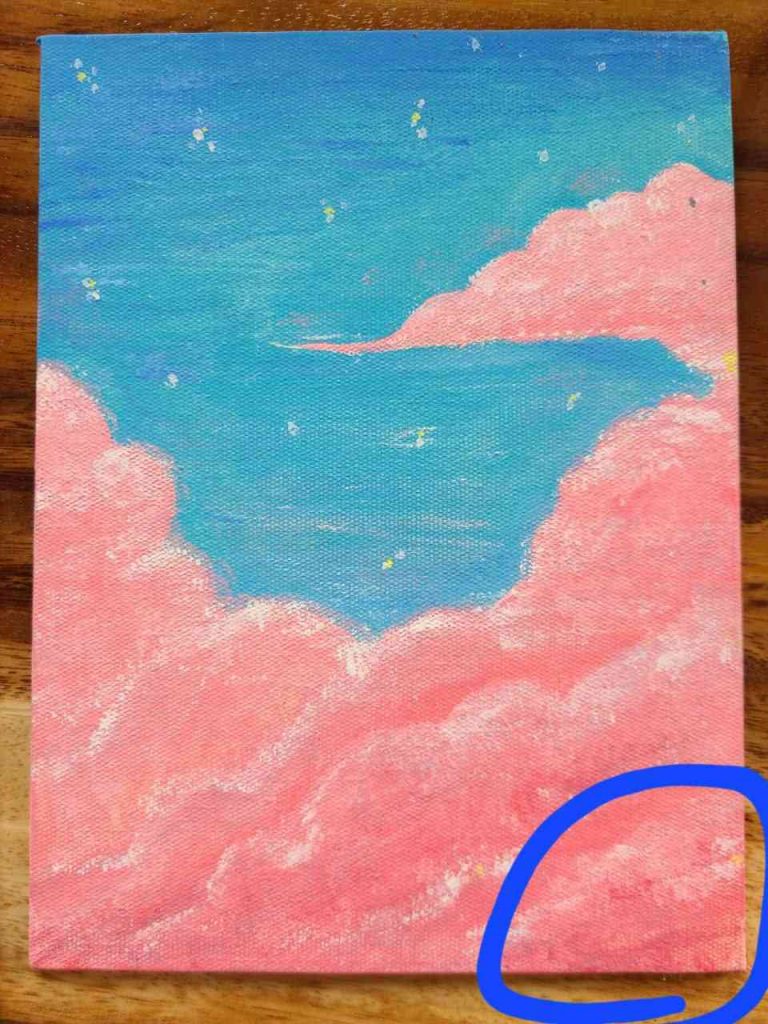

Gouache is reactivated with water, so it will get reactivated when in contact with water.
It is necessary to varnish your work and keep it in a frame to make it waterproof and water-resistant.
Acrylics are not waterproof, but they are water resistant, meaning they will not react when you accidentally splash water on them and they are washable if applied on walls.
It also still needs to be sealed to become waterproof.
Tip: Is Acrylic Paint Waterproof? 11 Ways To Make Acrylics Waterproof
Mediums and add-ons
Both gouache and acrylic can be used for mixed media art.
Gouache works well with watercolor and colored pencils, watercolor pencils, markers, and charcoals. You can also use pastels over dried gouache art.
Acrylic paints work well with other paint mediums, including gouache.
But you have to consider the placement of the paint medium when you use oil paint, which needs to be on top of the acrylic layer.
It can also be used with charcoals, colored pencils, and pastels.
Alcohol markers will not work with acrylic because they will muddy each other.
But you can still use them purposely to create interesting designs.
You can also add small embellishments like beads or glitters to acrylic because it can hold them permanently when dried.
To alter the texture and consistency of acrylics, you can add slow-drying mediums, pouring mediums, paste or gel for creating textures, mediums to make acrylic crack, and many other cool things!
Read also: 21 Top Gouache Painting Tips & Secrets From Pros
What are the similarities between gouache and acrylic?
Gouache and acrylic share some great qualities that make them easy to use like:
- Opacity
- Quick drying times
- Can be layered
- Relatively cheaper (compared to oil paints)
They are both loved by beginners and pro artists and allow us to create stunning paintings. Both gouache and acrylics are versatile and fun to paint with.
Read also: 29 Gouache Painting Ideas & 16 Famous Gouache Paintings You Will Love
Which is better, gouache or acrylic?
There is not one definite answer for which paint medium is better—gouache or acrylic.
If you are learning to blend colors, gouache will be easier for you. If you want more watercolor effects, gouache is better.
It all depends on your preference as a beginner or professional artist.
Both mediums have their pros and cons. And they also have cheaper options that make them both budget-friendly for beginner artists.
So, to help you decide what may be better for you, ask yourself these questions:
· Do I want to work on paper only, or do I want to try other painting surfaces?
If for paper only, use gouache. If you want to experience other painting surfaces, then use acrylic.
· Do I mostly want to create small artwork?
Gouache paints are great if you prefer to create smaller artwork that does not require too many details.
However, acrylic is much easier to work with for finer details because it dries quickly and does not reactivate with water.
· Do I want to sell my work in the future?
If yes, then you’re better with acrylic.
Otherwise, you need professional-grade gouache to improve the durability of your art and sell it. Acrylic paintings are easier to sell and can be priced extremely high.
· Do I want to display my work for a long time?
If you want durability, acrylic is made to last.
Some cheaper brands are also lightfast, so you don’t need to pay for professional-grade materials for a durable piece.
In contrast, you need to invest in professional-grade gouache to create a more durable art piece.
And even simpler question, do I like matte surface or shiny?
Do you want to create texture, play around with thicker layers or layer in general, or your want vibrant colors and soft edges? Are you used to work with watercolors and transparent pigments?
Then probably choose gouache first and then try acrylic paint.
Can gouache be used with acrylic?
Yes. You can use gouache with acrylic. You can even mix these paints to create a smooth and creamy paint medium that is easy to mix and blend but dries fast.
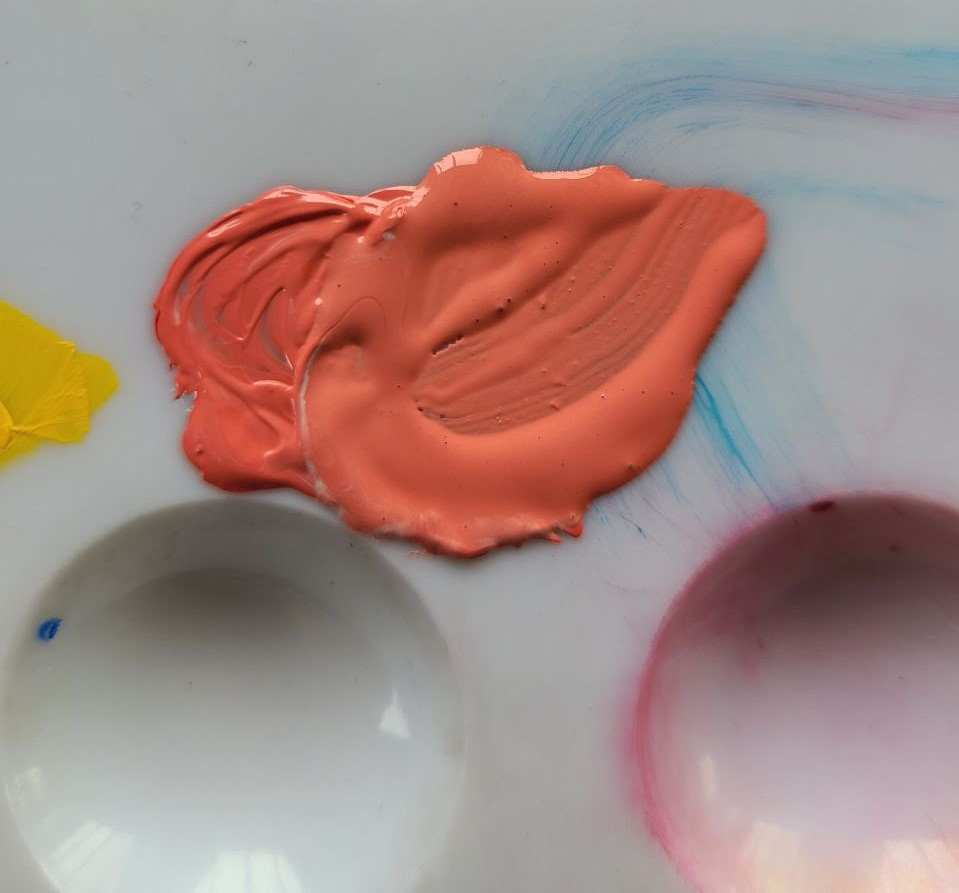

However, if you want to further explore the best qualities of gouache and acrylic together, it may be best to pick up and try painting with acryla gouache.
Acrylic gouache is very pigmented, so you only need thin layers of paint. It is still forgiving to blend because it has a slower drying time (compared to traditional gouache).
But once it dries, it sets permanently, like acrylic paint.
Lastly, it does not become brittle and crack, unlike traditional gouache.
Frequently Asked Questions
Are gouache and acrylic the same?
No. Gouache and acrylic are not the same, but they are both water-based paint mediums. They also share qualities like opacity and drying times but are completely different paint types.
Even the acrylic gouache is not entirely an acrylic paint. It is only a type of gouache that shares some similarities with acrylics, including its permanence once dried.
This is still gouache because it is more forgiving when mixing and blending colors than acrylic.
Do professional artists use gouache?
Yes. Professional artists and commercial artists use gouache.
And they have been using this medium for a long time. It is most commonly seen in comic books, illustrations, sketches posters, and animations, but also for landscapes. You can also easily make prints of gouache paintings.
And gouache paintings also sell well online. Some pieces, like the Lena Horne Painting by Christy Powers, are priced at $235. Bigger pieces can go upwards of $2,000, like the Bridal Shower by the same artist – Christy.
I must say I see more oils and acrylics being used for fine arts, but gouache is still extremely popular for all sorts of genres.
Is gouache better than acrylic for beginners?
Yes and no. And it highly depends on the wants and needs of the beginner painter.
Many artists suggest acrylic for beginners because it is cheaper and more durable. In addition, it is slightly forgiving because you can easily paint over an unsatisfying project and reuse the canvas.
You don’t need a special type of paper to paint with acrylic because you can paint on many different surfaces, including glass and plastic.
However, if the price is not really a problem, gouache can be better for beginners because it is more forgiving when mixing and blending colors for beginners.
Price may not also be a problem because there are now many cheap gouache set options that beginning painters on a budget can try.
Can you paint gouache over acrylic?
Yes. You can easily paint gouache over acrylic and vice versa.
Both mediums are water-based paints, so you can even paint them in any order without any issues.
Why use gouache instead of acrylic?
Use gouache instead of acrylic for smaller artworks that require minimal detail. It is also great for creating softer edges in your painting.
Also, choose gouache for your project if you want a more forgiving medium while practicing mixing and blending colors. It easily reactivates with water and blends well.
Final Thoughts
Gouache and acrylic are great to explore for beginners and professionals.
Both these mediums have their advantages and drawbacks, but they’re both still easy to control and affordable.
My final thought over gouache vs. acrylic is to use what you want, what you can afford, and what you think will be the best medium for you, considering all their differences and similarities.
For the next painting project try gouache or acrylic gouache and let me know what you think! Creating art should not be about limiting yourself to just one painting medium, explore and have fun.

Masha Eretnova, born in 1991, is a Buenos Aires-based certified teacher, artist, and member of the Professional Artist Association with 20+ years of personal painting journey.
She started painting and drawing very early and is now an international abstract artist and educator passionate about acrylic painting, gouache, and crafts.
Her works are part of international exhibitions and contests, including ArtlyMix (Brazil), Al-Tiba 9 (Spain), Exhibizone (Canada), Italy, and many more.
Besides her artistic pursuits, Masha holds a post-grad diploma in Teaching Film Photography and 2 music school diplomas: piano and opera singing.
